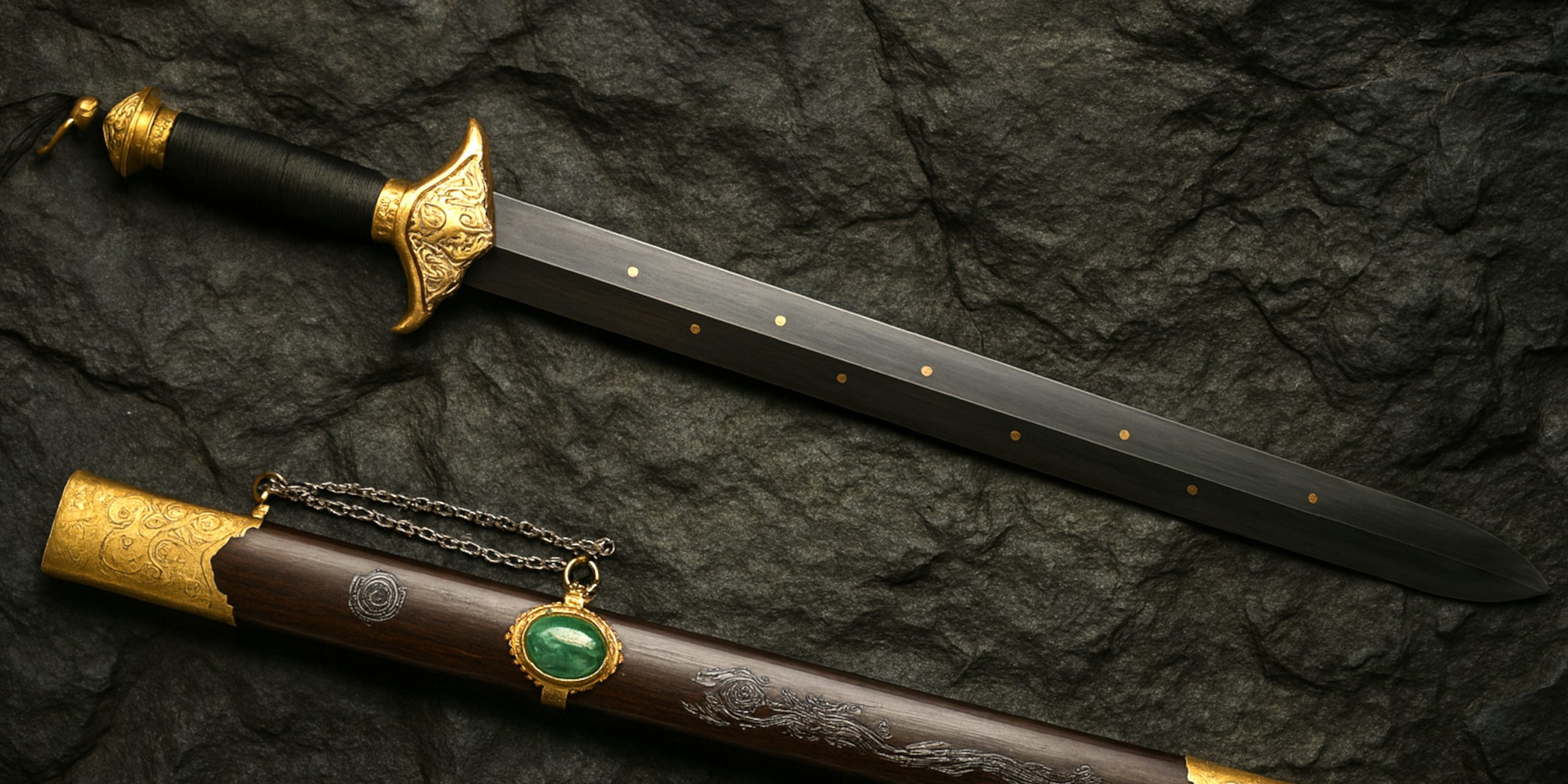
The Janggeom (장검) translates literally to “long sword” in Korean. It represents one of the longest and most prestigious forms of Korean bladed weapons, historically used by elite guards, generals, and ceremonial officials. While shorter Korean swords like the Hwando or Ssangdo were common for practical combat, the Janggeom stood apart as a weapon of authority and prestige, blending symbolism with deadly capability. Its presence in both military and royal contexts marks it as one of Korea’s most culturally significant swords.
Specification
| Feature | Description |
|---|---|
| Name | Janggeom (장검) – “Long Sword” |
| Type | Long straight sword (ceremonial and martial) |
| Overall Length | Typically 110–130 cm (43–51 in) |
| Blade Length | 80–100 cm (31–39 in) |
| Blade Type | Straight, double-edged (Jikdo-style), occasionally curved in later examples |
| Handle | Long wooden grip for one or two-handed use, often wrapped in silk or ray skin |
| Guard | Circular or octagonal cross-guard, brass or iron |
| Scabbard | Lacquered wood with metal fittings, often engraved or painted with motifs |
| Materials | High-carbon steel blade with ornate fittings in brass, silver, or gilt bronze |
| Balance | Weighted toward the hilt for controlled ceremonial gestures |
History and Evolution
- Three Kingdoms Period (57 BCE–668 CE):
Early long swords were rare but known in Goguryeo murals, often carried by mounted elites. These early prototypes were influenced by Chinese and steppe designs. - Goryeo Dynasty (918–1392):
The long sword began to symbolise status and command. It was used in military processions and by high-ranking officials. Blades were often straight and slim, reflecting Chinese jian aesthetics. - Joseon Dynasty (1392–1897):
The Janggeom took on a ceremonial identity, used by royal guards (Eoyonggun) and military academies. Swords of this era displayed exquisite craftsmanship with inscriptions, gold-inlaid dragons, and Buddhist symbols. - Late Joseon to Modern Era:
By the late 19th century, practical sword use had declined. The Janggeom transitioned entirely into a symbol of authority and cultural heritage, preserved through martial arts such as Haedong Gumdo and Kuk Sool Won.
Advantages and Disadvantages
| Advantages | Disadvantages |
|---|---|
| Impressive reach and striking power | Less practical in tight quarters |
| Ceremonial beauty and symbolic importance | Heavier and slower to draw |
| Superior craftsmanship and balance | Expensive to forge and maintain |
| Ideal for display, rituals, and martial demonstrations | Not suited to mass infantry use |
Comparison with Similar Weapons
| Weapon | Origin | Key Differences from Janggeom |
|---|---|---|
| Jikdo | Korea | Shorter, simpler straight sword for practical combat use |
| Hwando | Korea | Curved single-edged sabre for officers and soldiers |
| Ssanggeom | Korea | Paired long swords for advanced martial use, more ornate |
| Chinese Jian | China | Influenced early Janggeom form, typically lighter and thinner |
| Japanese Katana | Japan | Curved and optimised for cutting, unlike the Janggeom’s balanced thrusting design |
Legacy
The Janggeom embodies Korean martial heritage, blending artistry, philosophy, and military tradition. Its survival as both a ceremonial weapon and martial arts implement reflects Korea’s enduring respect for swordsmanship and craftsmanship.
Modern practitioners in Korean sword arts often train with replicas that preserve the weight and balance of historical examples. Museums and collectors alike regard original Janggeom as a pinnacle of late-Joseon metallurgy and artistry.
Where to See
| Location | Institution | Highlights |
|---|---|---|
| Seoul, South Korea | National Museum of Korea | Royal Janggeom with gold dragon motifs |
| Gyeonggi Province | Hwaseong Haenggung Palace Museum | Guard weapons from the late Joseon period |
| Busan Museum | Maritime ceremonial swords | |
| British Museum (London) | 19th-century Korean swords with inlaid inscriptions | |
| National Palace Museum of Korea | Ceremonial Janggeom used in court processions |
Collector’s Guide
Market Value and Availability
- Authentic Joseon-era Janggeom are extremely rare, often held in museums or private Korean collections.
- Replicas and reproduction swords are available for martial arts and display, typically ranging from £400 to £2,000 depending on quality and materials.
- Verified antiques (19th century) can fetch £10,000–£25,000 at auction depending on provenance, blade quality, and inscriptions.
What Collectors Look For
- Intact blade geometry and tang inscription (Myeongmun).
- Original scabbard lacquer and fittings.
- Provenance or royal/guard association.
- Signs of traditional folding and differential hardening in steel pattern.
Recent Auction Highlights
| Year | Auction House | Description | Price |
|---|---|---|---|
| 2024 | Bonhams London | Late-Joseon ceremonial Janggeom with gilt fittings | £18,700 |
| 2023 | Seoul Auction | 19th-century Janggeom inscribed with “Eoyonggun” (Royal Guard) | £22,000 |
| 2022 | Christie’s Hong Kong | Pair of gilt bronze-mounted Janggeom | £25,300 |
The SevenSwords Takeaway
The Janggeom stands as both a weapon and a work of art, representing Korea’s historical fusion of martial discipline and aesthetic refinement. Its lineage runs from battlefield utility to royal ceremony, echoing a civilisation that saw the sword not merely as a tool of war, but as a symbol of justice, honour, and spiritual balance.



